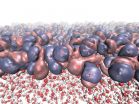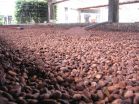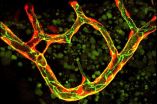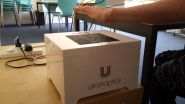Carnegie Mellon, Disney researchers develop acoustically driven controls for smartphones
A cheap, accessible way to add tangible interactivity to smartphone
2015-04-20
(Press-News.org) PITTSBURGH--As people find ever more inventive uses for smartphones, touchscreens sometimes fall short as control surfaces. Researchers at Carnegie Mellon University and Disney Research have developed an inexpensive alternative - a toolbox of physical knobs, sliders and other mechanisms that can be readily added to any device.
The researchers drew inspiration from wind instruments in devising these mechanisms, which they call Acoustruments. The idea is to use pluggable plastic tubes and other structures to connect the smartphone's speaker with its microphone. The device can then be controlled by acoustically altering sounds as they pass through this system.
Just as a simple slide whistle or flute can produce expressive music, these Acoustruments can add a wide range of functionality to a smartphone, including proximity and pressure sensors. And because no electrical circuitry is involved, the plastic Acoustruments can be made rapidly and inexpensively.
"We're providing people with tangible interactivity at basically no cost," said Gierad Laput, a Ph.D. student in Carnegie Mellon's Human-Computer Interaction Institute (HCII). Laput is the lead author of a study that will be presented April 22 at CHI 2015, the Conference on Human Factors in Computing Systems, in Seoul, Korea, and has been named a Best Paper by the conference organizers.
"Using smartphones as computers to control toys, appliances and robots already is a growing trend, particularly in the maker community," Laput added. "Acoustruments can make the interactivity of these new 'pluggable' applications even richer."
People who want to control a smartphone application while their eyes need to be focused elsewhere, for instance, might be less distracted by a tangible knob or button made possible with Acoustruments than with trying to glance at a touchscreen. Applications that use smartphones as virtual reality displays make it impossible to use the touchscreen controls at all; Acoustruments enable users to make adjustments without disrupting the virtual reality experience.
The CMU and Disney researchers have used Acoustruments to build an interactive doll, which responds when its tummy is poked; a smartphone case that can sense when it has been placed on a table or is being hand carried; and an alarm clock that provides physical on/off and snooze buttons.
Wind instruments take a sustained source of sound from a mouthpiece and then alter it by changing the cavity - with a series of holes, as in a flute, or by changing its size, as with a trombone. Acoustruments operate in a similar manner; the smartphone speaker produces continuous "sweeps" of ultrasonic frequencies; interactions that block, open holes or change the length or diameter of the plastic tubes connecting the speaker to the microphone alter this acoustic signal.
Experiments by the CMU and Disney researchers showed that Acoustruments can achieve 99 percent accuracy in controlling the device.
Acoustruments can be made with 3-D printers, with injection molds, or even by hand in some cases, Laput said. The ultrasonic frequencies are inaudible to people and the pluggable structures are designed to block out interference from external noise.
INFORMATION:
In addition to Laput, the research team included Eric Brockmeyer of Disney Research Pittsburgh and two HCII faculty members, Scott Hudson and Chris Harrison. The research was sponsored by Disney
Research.
About Carnegie Mellon University
Carnegie Mellon is a private, internationally ranked research university with programs in areas ranging from science, technology and business, to public policy, the humanities and the arts. More than 13,000 students in the university's seven schools and colleges benefit from a small student-to- faculty ratio and an education characterized by its focus on creating and implementing solutions for real problems, interdisciplinary collaboration and innovation. A global university, Carnegie Mellon has campuses in Pittsburgh, Pa., California's Silicon Valley and Qatar, and programs in Africa, Asia, Australia, Europe and Mexico.
About Disney Research
Disney Research is a network of research laboratories supporting The Walt Disney Company. Its purpose is to pursue scientific, and technological innovation to advance the company's broad media and entertainment efforts. Disney Research is managed by an internal Disney Research Council co-chaired by Disney-Pixar's Ed Catmull and Walt Disney Imagineering's Bruce Vaughn, and including the directors of the individual labs. It has facilities in Los Angeles, San Francisco, Pittsburgh, Boston and Zurich. Research topics include Computer Graphics, Video Processing, Computer Vision, Robotics, Radio and Antennas, Wireless Communications, Human-Computer Interaction, Displays, Data Mining, Machine Learning and Behavioral Sciences.
[Attachments] See images for this press release:
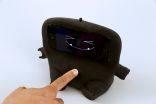
ELSE PRESS RELEASES FROM THIS DATE:
2015-04-20
ATLANTA -April 20, 2015- Despite strong evidence and guidelines supporting its use, post-surgical radiation therapy for prostate cancer patients at risk of recurrence is declining in the United States. The study, published online in the journal European Urology, finds fewer than 10 percent of patients at risk of recurrence received postoperative radiotherapy within six months of surgery in the U.S.
Although radical prostatectomy (RP) is a common curative treatment for localized prostate cancer, about 30% of patients will develop biochemical recurrence after surgery, ...
2015-04-20
The National Physical Laboratory (NPL), the UK's National Measurement Institute in collaboration with IBM and the University of Edinburgh, has used a new quantum model to reveal the molecular structure of water's liquid surface.
The liquid-vapour interface of water is one of the most common of all heterogeneous (or non-uniform) environments. Understanding its molecular structure will provide insight into complex biochemical interactions underpinning many biological processes. But experimental measurements of the molecular structure of water's surface are challenging, ...
2015-04-20
The discovery of a gene involved in determining the melting point of cocoa butter -- a critical attribute of the substance widely used in foods and pharmaceuticals -- will likely lead to new and improved products, according to researchers in Penn State's College of Agricultural Sciences.
The finding by plant geneticists also should lead to new varieties of the cocoa plant that could extend the climate and soil-nutrient range for growing the crop and increase the value of its yield, they said, providing a boost to farmers' incomes in the cocoa-growing regions of the world.
Cacao, ...
2015-04-20
Singapore, 20 April 2015 - Since the discovery of graphene about a decade ago, scientists have been studying ways to engineer electronic band gaps in the material to produce semiconductors which can create new electronic devices. A team of researchers from Yale-NUS College, the Center for Advanced 2D Materials and Department of Physics at the National University of Singapore (NUS) and the University of Texas at Austin, USA (UT Austin) have established a theoretical framework to understand the elastic and electronic properties of graphene. The findings were published in ...
2015-04-20
As two galaxies enter the final stages of merging, scientists have theorized that the galaxies' supermassive black holes will form a "binary," or two black holes in such close orbit they are gravitationally bound to one another. In a new study, astronomers at the University of Maryland present direct evidence of a pulsing quasar, which may substantiate the existence of black hole binaries.
"We believe we have observed two supermassive black holes in closer proximity than ever before," said Suvi Gezari, assistant professor of astronomy at the University of Maryland and ...
2015-04-20
Research by scientists at The University of Manchester has revealed that the colour of light has a major impact on how our body clock measures the time of day.
It's the first time the impact of colour has been tested and demonstrates that colour provides a more reliable way of telling the time than measuring brightness.
In research being published on April 17th in the Open Access journal PLOS Biology, the researchers looked at the change in light around dawn and dusk to analyse whether colour could be used to determine time of day. Besides the well-known changes in ...
2015-04-20
Cells of the vascular system of vertebrates can fuse with themselves. This process, which occurs when a blood vessel is no longer necessary and pruned, has now been described on the cellular level by Prof. Markus Affolter from the Biozentrum of the University of Basel. The findings of this study have been published in the journal PLOS Biology.
The vascular system is the supply network of the human organism and delivers oxygen and nutrients to the last corners of the body. So far, research on the vascular system has focused primarily on the formation of such vascular networks. ...
2015-04-20
The horticulturist who came up with the concept of 'evolution by natural selection' 27 years before Charles Darwin did should be more widely acknowledged for his contribution, states a new paper by a King's College London geneticist.
The paper, published in the Biological Journal of the Linnean Society, argues that Patrick Matthew deserves to be considered alongside Charles Darwin and Alfred Russel Wallace as one of the three originators of the idea of large-scale evolution by natural selection.
Furthermore, Matthew's version of evolution by natural section captures ...
2015-04-20
Human emotion can be transferred by technology that stimulates different parts of the hand without making physical contact with your body, a University of Sussex-led study has shown.
Sussex scientist Dr Marianna Obrist, Lecturer at the Department of Informatics, has pinpointed how next-generation technologies can stimulate different areas of the hand to convey feelings of, for example, happiness, sadness, excitement or fear.
For example, short, sharp bursts of air to the area around the thumb, index finger and middle part of the palm generate excitement, whereas sad ...
2015-04-20
Philadelphia, PA, April 20, 2015 - The search for genes that contribute to the risk for autism has made tremendous strides over the past 3 years. As this field has advanced, investigators have wondered whether the diversity of clinical features across patients with autism reflects heterogeneous sources of genetic risk.
If so, it was reasoned, then selecting a group of patients with very similar clinical features might result in a "purer", i.e., more genetically homogenous, group of patients, making it easier to find autism-related genes.
Results from a new study published ...
LAST 30 PRESS RELEASES:
[Press-News.org] Carnegie Mellon, Disney researchers develop acoustically driven controls for smartphones
A cheap, accessible way to add tangible interactivity to smartphone

